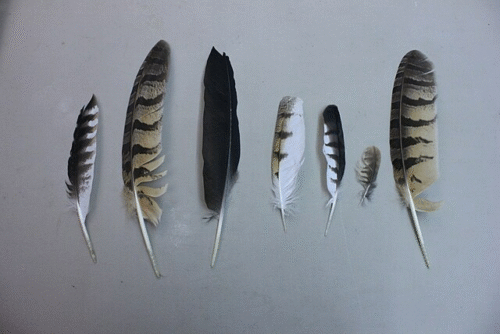The Ancient Art of Feather Repair -Imping

In Dancing with Dragons we meet Half-Wing a fairy dragon with deformed wing feathers, rendering him unable to fly. In the course of the story, the Lord Physician to Dragons, Sir Edward Dressler, offers to help Half Wing using a procedure to repair broken flight feathers.
I’m sure you’re not surprised that this process, called imping, was one of those I discovered on a trip down the research rabbit hole. I thought you might find it as interesting as I did.
Feathers are essential for a bird’s flight—you never would have guessed, right? The primary feathers (outer wings) and tail (rectrices) steer their air, help them dive, glide, and land. Even one missing or broken feather can compromise a bird’s ability to fly, hunt or escape predators.
When a bird molts, new feathers will grow in, but that could take months. Imping gets the injured birds back outside faster—making rescue and rehab kinder to the bird, and more effective.
What Is Imping?

Imping is the process of repairing a bird’s broken feather(s) by carefully splicing a donor feather into the damaged one, using a tiny dowel—made from bamboo, metal, or modern materials like fiberglass. Then, tiny drops of glue hold it steady and aligned. Historically, falconers used iron and even rusty water as glue, but today we have fast-drying epoxy and precision tools for more precise results.
Because feathers are made of dead keratin (just like our hair and nails), imping doesn’t hurt the bird. But it requires precision and skill. Even a tiny misalignment could ruin a bird’s chance to fly properly after release.
Imping in History
Imping has been around for hundreds of years. One of the earliest known mentions comes from Emperor Frederick II in the 1240s. He wrote about “imponere”—Latin for “to place upon.” Even Shakespeare mentioned something like it in Richard II, using it as a metaphor: “Imp out our drooping country’s broken wing.” Knowing what imping actually means brings a whole new meaning to the phrase, doesn’t it?
Today, wildlife centers like the Audubon Center for Birds of Prey and the Toronto Wildlife Centre use imping to help injured birds heal faster so they don’t stay in care for months waiting on molting to replace damaged feathers.
The Imping Process
Imping can involve single feathers or aim to repair damage on a much larger scale. At Toronto’s center, a long-eared owl with seventeen broken feathers got them all replaced from a feather bank, built up from molted feathers, kept on site for the purpose.
Whether on a single feather, or many the process is the same:
- Choose a matching feather.
Find a donor feather that matches exactly—same wing part and same length - Cut the broken feather.
Snip the feather about 1–2 cm from the base to make a solid anchor for the new feather - Prep the dowel (“imping needle”).
Use a slender bamboo or fiberglass dowel to fit snugly into both hollow shafts - Join the feathers.
Brush on epoxy and slide the new feather onto the dowel and into the old shaft. Align it perfectly - Clean up and test it.
Remove stickiness, smooth the glue, and check that the vanes align. Sometimes birds are test-flown to see if they glide right. If not, the bird might molt off the imped feather (rejecting the graft as it were) and be in even worse condition than it started.
When the bird molts naturally, the imping feather will fall out and be replaced with a fresh, healthy feather.
Even though the idea is simple—”stick in a new feather”—the details matter. The feathers have to match exactly in length and curve. (Some experts in imping are even skilled enough to adjust non-matching feathers to the purpose!) The glue needs to be just right: not too much, not too little. Angles must be perfect, not unlike the flaps of an airplane wing. All things which require skill and practice on the part of the falconer.
Is it any wonder why Half Wing took his time considering whether or not he was willing to try the procedure for himself?
Resources
Barsony, Melanie. The Art of Imping: The Dynamics of Raptor Feather Repair. Australian Raptor Care & Conservation, 2017 https://www.awrc.org.au/uploads/5/8/6/6/5866843/15_melanie_barsony_the_art_of_imping_melanie_final.pdf
Fixing Feathers: Returning Injured Birds to the Sky!. Toronto Wildlife Centre. 2018 https://www.torontowildlifecentre.com/fixing-feathers-returning-injured-birds-sky/ Accessed January 25, 2025
McGlashen, Andy. An Introduction to Imping, the Ancient Art of Feather-Mending. Audubon. 2017 https://www.audubon.org/news/an-introduction-imping-ancient-art-feather-mending Accessed January 25, 2025
- Feather Imping on a Great Horned Owl. August, 2018. https://discoverwildcare.org/fixing-a-great-horned-owls-feathers/ Accessed January 25, 2025

Very interesting! I didn’t know the technique was so ancient.
I just have to tell you how much I enjoy your newsletters, particularly the Down the Research Rabbit Hole. I was pleased to see the post about Imping. There is a wildlife rescue in Nova Scotia, Canada that has television program called Hope for Wildlife and a wildlife hospital in Australia called Wildlife ER. They both have had episodes featuring Imping. So I had some knowledge of it already when I read your newsletter. And like you, I often fall down that Research Rabbit Hole. I may keep tabs open for days (or weeks) while I go from one link to another. The internet has been my best friend. There’s so much out there. You never know what gem you’ll find as you go. Your site does this so well. So, thank you for your thoroughness and your research. You are a gem.
I feel all of your books are so well thought out, and love all the research you share. Thank you for all the knowledge and wonderful books you share.